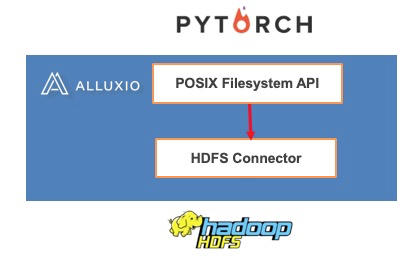By Biran
Google's TensorFlow and Facebook's PyTorch are two popular deep learning frameworks in the community. Although PyTorch is relatively new, it has developed rapidly due to its developer-friendly experience. However, PyTorch disallows directly training models in Hadoop Distributed File System (HDFS) by default. This makes it difficult for many users who store datasets in HDFS. Therefore, for training models, it necessitates users to export data from HDFS or modify the source code of PyTorch to support the HDFS protocol. This elaborate process greatly compromises the user experience.
In contrast, Alluxio is capable of translating the HDFS API to a POSIX Filesystem API. This feature frees PyTorch developers from the need to modify the computing framework, and therefore dramatically improves development efficiency.

This article describes how to verify the entire work in Kubernetes environments.
If no existing HDFS cluster is available, directly install HDFS by using a Helm Chart.
1) Install a Helm Chart with Hadoop 2.7.2.
git clone https://github.com/cheyang/kubernetes-HDFS.git
kubectl label nodes cn-huhehaote.192.168.0.117 hdfs-namenode-selector=hdfs-namenode-0
#helm install -f values.yaml hdfs charts/hdfs-k8s
helm dependency build charts/hdfs-k8s
helm install hdfs charts/hdfs-k8s \
--set tags.ha=false \
--set tags.simple=true \
--set global.namenodeHAEnabled=false \
--set hdfs-simple-namenode-k8s.nodeSelector.hdfs-namenode-selector=hdfs-namenode-02) Check the status of the Helm Chart.
kubectl get all -l release=hdfs3) Use an HDFS-CLI client to connect to the HDFS.
kubectl exec -it hdfs-client-f5bc448dd-rc28d bash
root@hdfs-client-f5bc448dd-rc28d:/# hdfs dfsadmin -report
Configured Capacity: 422481862656 (393.47 GB)
Present Capacity: 355748564992 (331.32 GB)
DFS Remaining: 355748515840 (331.32 GB)
DFS Used: 49152 (48 KB)
DFS Used%: 0.00%
Under replicated blocks: 0
Blocks with corrupt replicas: 0
Missing blocks: 0
Missing blocks (with replication factor 1): 0
-------------------------------------------------
Live datanodes (2):
Name: 172.31.136.180:50010 (172-31-136-180.node-exporter.arms-prom.svc.cluster.local)
Hostname: iZj6c7rzs9xaeczn47omzcZ
Decommission Status : Normal
Configured Capacity: 211240931328 (196.73 GB)
DFS Used: 24576 (24 KB)
Non DFS Used: 32051716096 (29.85 GB)
DFS Remaining: 179189190656 (166.88 GB)
DFS Used%: 0.00%
DFS Remaining%: 84.83%
Configured Cache Capacity: 0 (0 B)
Cache Used: 0 (0 B)
Cache Remaining: 0 (0 B)
Cache Used%: 100.00%
Cache Remaining%: 0.00%
Xceivers: 1
Last contact: Tue Mar 31 16:48:52 UTC 20204) Configure the HDFS-CLI client.
[root@iZj6c61fdnjcrcrc2sevsfZ kubernetes-HDFS]# kubectl exec -it hdfs-client-f5bc448dd-rc28d bash
root@hdfs-client-f5bc448dd-rc28d:/# cat /etc/hadoop-custom-conf
cat: /etc/hadoop-custom-conf: Is a directory
root@hdfs-client-f5bc448dd-rc28d:/# cd /etc/hadoop-custom-conf
root@hdfs-client-f5bc448dd-rc28d:/etc/hadoop-custom-conf# ls
core-site.xml hdfs-site.xml
root@hdfs-client-f5bc448dd-rc28d:/etc/hadoop-custom-conf# cat core-site.xml
<? xml version="1.0"? >
<? xml-stylesheet type="text/xsl" href="configuration.xsl"? >
<configuration>
<property>
<name>fs.defaultFS</name>
<value>hdfs://hdfs-namenode-0.hdfs-namenode.default.svc.cluster.local:8020</value>
</property>
</configuration>
root@hdfs-client-f5bc448dd-rc28d:/etc/hadoop-custom-conf# cat hdfs-site.xml
<? xml version="1.0"? >
<? xml-stylesheet type="text/xsl" href="configuration.xsl"? >
<configuration>
<property>
<name>dfs.namenode.name.dir</name>
<value>file:///hadoop/dfs/name</value>
</property>
<property>
<name>dfs.namenode.datanode.registration.ip-hostname-check</name>
<value>false</value>
</property>
<property>
<name>dfs.datanode.data.dir</name>
<value>/hadoop/dfs/data/0</value>
</property>
</configuration>
root@hdfs-client-f5bc448dd-rc28d:/etc/hadoop-custom-conf# hadoop --version
Error: No command named `--version' was found. Perhaps you meant `hadoop -version'
root@hdfs-client-f5bc448dd-rc28d:/etc/hadoop-custom-conf# hadoop -version
Error: No command named `-version' was found. Perhaps you meant `hadoop version'
root@hdfs-client-f5bc448dd-rc28d:/etc/hadoop-custom-conf# hadoop version
Hadoop 2.7.2
Subversion https://git-wip-us.apache.org/repos/asf/hadoop.git -r b165c4fe8a74265c792ce23f546c64604acf0e41
Compiled by jenkins on 2016-01-26T00:08Z
Compiled with protoc 2.5.0
From source with checksum d0fda26633fa762bff87ec759ebe689c
This command was run using /opt/hadoop-2.7.2/share/hadoop/common/hadoop-common-2.7.2.jar5) Verify basic file operations on the HDFS.
# hdfs dfs -ls /
Found 1 items
drwxr-xr-x - root supergroup 0 2020-03-31 16:51 /test
# hdfs dfs -mkdir /mytest
# hdfs dfs -copyFromLocal /etc/hadoop/hadoop-env.cmd /test/
# hdfs dfs -ls /test
Found 2 items
-rw-r--r-- 3 root supergroup 3670 2020-04-20 08:51 /test/hadoop-env.cmd6) Download data.
mkdir -p /data/MNIST/raw/
cd /data/MNIST/raw/
wget http://kubeflow.oss-cn-beijing.aliyuncs.com/mnist/train-images-idx3-ubyte.gz
wget http://kubeflow.oss-cn-beijing.aliyuncs.com/mnist/train-labels-idx1-ubyte.gz
wget http://kubeflow.oss-cn-beijing.aliyuncs.com/mnist/t10k-images-idx3-ubyte.gz
wget http://kubeflow.oss-cn-beijing.aliyuncs.com/mnist/t10k-labels-idx1-ubyte.gz
hdfs dfs -mkdir -p /data/MNIST/raw
hdfs dfs -copyFromLocal *.gz /data/MNIST/raw1) Select one or more specified nodes.
kubectl label nodes cn-huhehaote.192.168.0.117 dataset=mnist2) Create config.yaml. In particular, set the node selector to the specified node.
cat << EOF > config.yaml
image: registry.cn-huhehaote.aliyuncs.com/alluxio/alluxio
imageTag: "2.2.0-SNAPSHOT-b2c7e50"
nodeSelector:
dataset: mnist
properties:
alluxio.fuse.debug.enabled: "false"
alluxio.user.file.writetype.default: MUST_CACHE
alluxio.master.journal.folder: /journal
alluxio.master.journal.type: UFS
alluxio.master.mount.table.root.ufs: "hdfs://hdfs-namenode-0.hdfs-namenode.default.svc.cluster.local:8020"
worker:
jvmOptions: " -Xmx4G "
master:
jvmOptions: " -Xmx4G "
tieredstore:
levels:
- alias: MEM
level: 0
quota: 20GB
type: hostPath
path: /dev/shm
high: 0.99
low: 0.8
fuse:
image: registry.cn-huhehaote.aliyuncs.com/alluxio/alluxio-fuse
imageTag: "2.2.0-SNAPSHOT-b2c7e50"
jvmOptions: " -Xmx4G -Xms4G "
args:
- fuse
- --fuse-opts=direct_io
EOF3) Install Alluxio.
wget http://kubeflow.oss-cn-beijing.aliyuncs.com/alluxio-0.12.0.tgz
tar -xvf alluxio-0.12.0.tgz
helm install alluxio -f config.yaml alluxio4) Check the status of Alluxio until all components are in the ready state.
helm get manifest alluxio | kubectl get -f -
NAME TYPE CLUSTER-IP EXTERNAL-IP PORT(S) AGE
service/alluxio-master ClusterIP None <none> 19998/TCP,19999/TCP,20001/TCP,20002/TCP 14h
NAME DESIRED CURRENT READY UP-TO-DATE AVAILABLE NODE SELECTOR AGE
daemonset.apps/alluxio-fuse 4 4 4 4 4 <none> 14h
NAME DESIRED CURRENT READY UP-TO-DATE AVAILABLE NODE SELECTOR AGE
daemonset.apps/alluxio-worker 4 4 4 4 4 <none> 14h
NAME READY AGE
statefulset.apps/alluxio-master 1/1 14h1) Prepare a Dockerfile.
mkdir pytorch-mnist
cd pytorch-mnist
vim DockerfileFROM pytorch/pytorch:1.4-cuda10.1-cudnn7-devel
# pytorch/pytorch:1.4-cuda10.1-cudnn7-devel
ADD mnist.py /
CMD ["python", "/mnist.py"]2) Prepare a test code file named mnist.py.
cd pytorch-mnist
vim mnist.py# -*- coding: utf-8 -*-
# @Author: cheyang
# @Date: 2020-04-18 22:41:12
# @Last Modified by: cheyang
# @Last Modified time: 2020-04-18 22:44:06
from __future__ import print_function
import argparse
import torch
import torch.nn as nn
import torch.nn.functional as F
import torch.optim as optim
from torchvision import datasets, transforms
from torch.optim.lr_scheduler import StepLR
class Net(nn.Module):
def __init__(self):
super(Net, self).__init__()
self.conv1 = nn.Conv2d(1, 32, 3, 1)
self.conv2 = nn.Conv2d(32, 64, 3, 1)
self.dropout1 = nn.Dropout2d(0.25)
self.dropout2 = nn.Dropout2d(0.5)
self.fc1 = nn.Linear(9216, 128)
self.fc2 = nn.Linear(128, 10)
def forward(self, x):
x = self.conv1(x)
x = F.relu(x)
x = self.conv2(x)
x = F.relu(x)
x = F.max_pool2d(x, 2)
x = self.dropout1(x)
x = torch.flatten(x, 1)
x = self.fc1(x)
x = F.relu(x)
x = self.dropout2(x)
x = self.fc2(x)
output = F.log_softmax(x, dim=1)
return output
def train(args, model, device, train_loader, optimizer, epoch):
model.train()
for batch_idx, (data, target) in enumerate(train_loader):
data, target = data.to(device), target.to(device)
optimizer.zero_grad()
output = model(data)
loss = F.nll_loss(output, target)
loss.backward()
optimizer.step()
if batch_idx % args.log_interval == 0:
print('Train Epoch: {} [{}/{} ({:.0f}%)]\tLoss: {:.6f}'.format(
epoch, batch_idx * len(data), len(train_loader.dataset),
100. * batch_idx / len(train_loader), loss.item()))
def test(model, device, test_loader):
model.eval()
test_loss = 0
correct = 0
with torch.no_grad():
for data, target in test_loader:
data, target = data.to(device), target.to(device)
output = model(data)
test_loss += F.nll_loss(output,
target,
reduction='sum').item()
pred = output.argmax(dim=1, keepdim=True)
correct += pred.eq(target.view_as(pred)).sum().item()
test_loss /= len(test_loader.dataset)
print('\nTest set: Average loss: {:.4f}, Accuracy: {}/{} ({:.0f}%)\n'.format(
test_loss, correct, len(test_loader.dataset),
100. * correct / len(test_loader.dataset)))
def main():
# Training settings
parser = argparse.ArgumentParser(description='PyTorch MNIST Example')
parser.add_argument('--batch-size', type=int, default=64, metavar='N',
help='input batch size for training (default: 64)')
parser.add_argument('--test-batch-size', type=int,
default=1000,
metavar='N',
help='input batch size for testing (default: 1000)')
parser.add_argument('--epochs', type=int, default=14, metavar='N',
help='number of epochs to train (default: 14)')
parser.add_argument('--lr', type=float, default=1.0, metavar='LR',
help='learning rate (default: 1.0)')
parser.add_argument('--gamma', type=float, default=0.7, metavar='M',
help='Learning rate step gamma (default: 0.7)')
parser.add_argument('--no-cuda', action='store_true', default=False,
help='disables CUDA training')
parser.add_argument('--seed', type=int, default=1, metavar='S',
help='random seed (default: 1)')
parser.add_argument('--log-interval', type=int, default=10, metavar='N',
help='how many batches to wait before logging training status')
parser.add_argument('--save-model', action='store_true', default=False,
help='For Saving the current Model')
args = parser.parse_args()
use_cuda = not args.no_cuda and torch.cuda.is_available()
torch.manual_seed(args.seed)
device = torch.device("cuda" if use_cuda else "cpu")
kwargs = {'num_workers': 1, 'pin_memory': True} if use_cuda else {}
train_loader = torch.utils.data.DataLoader(
datasets.MNIST('../data', train=True, download=True,
transform=transforms.Compose([
transforms.ToTensor(),
transforms.Normalize((0.1307,), (0.3081,))
])),
batch_size=args.batch_size, shuffle=True, **kwargs)
test_loader = torch.utils.data.DataLoader(
datasets.MNIST('../data', train=False, transform=transforms.Compose([
transforms.ToTensor(),
transforms.Normalize((0.1307,), (0.3081,))
])),
batch_size=args.test_batch_size, shuffle=True, **kwargs)
model = Net().to(device)
optimizer = optim.Adadelta(model.parameters(), lr=args.lr)
scheduler = StepLR(optimizer, step_size=1, gamma=args.gamma)
for epoch in range(1, args.epochs + 1):
train(args, model, device, train_loader, optimizer, epoch)
test(model, device, test_loader)
scheduler.step()
if args.save_model:
torch.save(model.state_dict(), "mnist_cnn.pt")
if __name__ == '__main__':
main()3) Create a custom image at the same directory level as the test code file. In this example, the target container image is registry.cn-shanghai.aliyuncs.com/tensorflow-samples/mnist:pytorch-1.4-cuda10.1-cudnn7-devel.
docker build -t \
registry.cn-shanghai.aliyuncs.com/tensorflow-samples/mnist:pytorch-1.4-cuda10.1-cudnn7-devel .4) Submit the created image registry.cn-shanghai.aliyuncs.com/tensorflow-samples/mnist:pytorch-1.4-cuda10.1-cudnn7-devel to the image repository that was created in the China (Hangzhou) region. For more information, see Basic Image Operations.
1) Install Arena.
$ wget http://kubeflow.oss-cn-beijing.aliyuncs.com/arena-installer-0.3.3-332fcde-linux-amd64.tar.gz
$ tar -xvf arena-installer-0.3.3-332fcde-linux-amd64.tar.gz
$ cd arena-installer/
$ ./install.
$ yum install bash-completion -y
$ echo "source <(arena completion bash)" >> ~/.bashrc
$ chmod u+x ~/.bashrc2) Submit a training task by using Arena. Ensure that dataset=mnist is selected for the selector.
arena submit tf \
--name=alluxio-pytorch \
--selector=dataset=mnist \
--data-dir=/alluxio-fuse/data:/data \
--gpus=1 \
--image=registry.cn-shanghai.aliyuncs.com/tensorflow-samples/mnist:pytorch-1.4-cuda10.1-cudnn7-devel \
"python /mnist.py"3) View training logs in Arena.
# arena logs --tail=20 alluxio-pytorch
Train Epoch: 12 [49280/60000 (82%)] Loss: 0.021669
Train Epoch: 12 [49920/60000 (83%)] Loss: 0.008180
Train Epoch: 12 [50560/60000 (84%)] Loss: 0.009288
Train Epoch: 12 [51200/60000 (85%)] Loss: 0.035657
Train Epoch: 12 [51840/60000 (86%)] Loss: 0.006190
Train Epoch: 12 [52480/60000 (87%)] Loss: 0.007776
Train Epoch: 12 [53120/60000 (88%)] Loss: 0.001990
Train Epoch: 12 [53760/60000 (90%)] Loss: 0.003609
Train Epoch: 12 [54400/60000 (91%)] Loss: 0.001943
Train Epoch: 12 [55040/60000 (92%)] Loss: 0.078825
Train Epoch: 12 [55680/60000 (93%)] Loss: 0.000925
Train Epoch: 12 [56320/60000 (94%)] Loss: 0.018071
Train Epoch: 12 [56960/60000 (95%)] Loss: 0.031451
Train Epoch: 12 [57600/60000 (96%)] Loss: 0.031353
Train Epoch: 12 [58240/60000 (97%)] Loss: 0.075761
Train Epoch: 12 [58880/60000 (98%)] Loss: 0.003975
Train Epoch: 12 [59520/60000 (99%)] Loss: 0.085389
Test set: Average loss: 0.0256, Accuracy: 9921/10000 (99%)Earlier, running a PyTorch program on HDFS required modifying the code of the PyTorch adapter. Now, Alluxio simplifies adaptation, allowing you to quickly develop and train models. The preceding work becomes quite simple on Alibaba Cloud Kubernetes platform. We strongly encourage you to try it out!
Backup and Recovery Solution for Disk-based Data Volumes in Kubernetes Clusters

182 posts | 32 followers
FollowAlibaba Container Service - August 25, 2020
Alibaba Developer - March 1, 2022
Alibaba Cloud_Academy - June 26, 2023
Alibaba Cloud Native Community - March 1, 2022
youliang - February 5, 2021
Alibaba EMR - November 18, 2020

182 posts | 32 followers
Follow Container Registry
Container Registry
A secure image hosting platform providing containerized image lifecycle management
Learn More Container Service for Kubernetes
Container Service for Kubernetes
Alibaba Cloud Container Service for Kubernetes is a fully managed cloud container management service that supports native Kubernetes and integrates with other Alibaba Cloud products.
Learn More ACK One
ACK One
Provides a control plane to allow users to manage Kubernetes clusters that run based on different infrastructure resources
Learn More Cloud-Native Applications Management Solution
Cloud-Native Applications Management Solution
Accelerate and secure the development, deployment, and management of containerized applications cost-effectively.
Learn MoreMore Posts by Alibaba Container Service